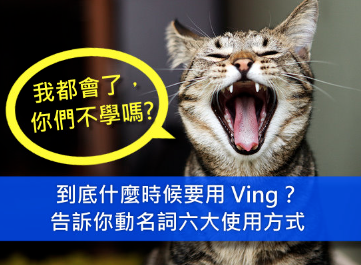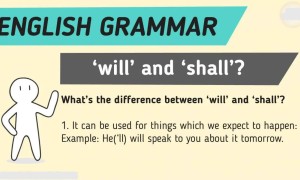有许多人不知道何时动词后面要加 ing,
也完全不懂动名词在句子中是当受词还是主词,
别再担心搞不清楚了!
让 VT 用简单明了的六大规则,
带你征服 Ving 的世界!
Type 1: Running is good for your heart. 动名词当主词
“Running” 是动名词,也是句子中的主词,后面接着动词 “is”,记住动词是「单数」型态喔!
Type 2: He hates waking up early. 动名词当部分动词的受词
“waking” 是动名词,而 “waking up” 这个词是句子中的名词部分,”He” 是主词,”hates” 是动词。
【补充】
“go + Ving” 是很常见的特殊用法,例如:go swimming、go hiking、go fishing 等,通常用于户外活动。除此之外,你想知道哪些动词后面要加 ing 吗?小编为大家整理出以下表格:

后面一定要加 Ving 的动词 admit discuss mind putoff
appreciate dislike miss quit
avoid enjoy permit recommend
can’t help finish postpone risk
consider keep practice suggest
后面可以加 to V 也可以加 Ving (意思不变) begin like hate start
love can’t stand continue prefer
can’t bear attempt
后面可以加 to V 也可以加 Ving (意思不同) remember regret forget try
Type 3: What I hate most is repeating myself. 动名词当主词补语
这个句子中的主词是 “What I hate most”, “is” 是动词,而 “repeating myself” 就是在当名词用,这里的动名词角色是要补充说明主词。
Type 4: I saw Jim riding his bike. 动名词当受词补语
“I” 是主词,”saw” 是动词,”Jim” 是受词,”riding his bike” 就是受词补语,在辅助说明 Jim 在做什么。
Type 5: I’m interested in improving myself. 动名词当介系词的受词
这个用法很常见,母语人士都很喜欢用。英文中有许多形容词+介系词的组合,通常在介系词之后可以加上动名词作为介系词的受词。因此,”improving myself” 就是受词。
e.g., I am excited (形容词) about (介系词) doing something (受词).
e.g., I am used (形容词) to (介系词) doing something (受词).
Type 6: She doesn’t like your bossing her around. 动名词当所有格的受词补语
最后一种用法比较困难,也比较容易忘记。 ”your” 这个所有格是受词,而 “bossing” 就是担任所有格受词补语的角色,用来再多加补充 “your” 这个受词。
e.g., I (主词) don’t like (动词) her (受词) cooking (受词补语).







